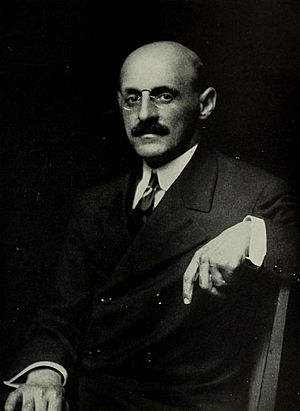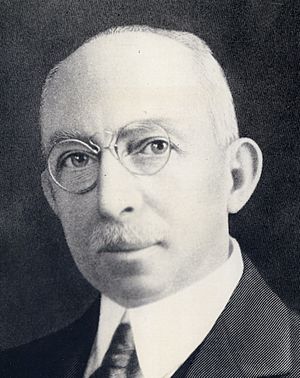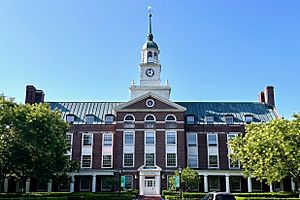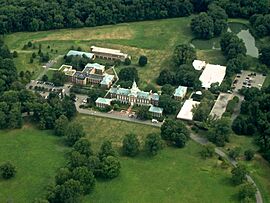Institute for Advanced Study facts for kids
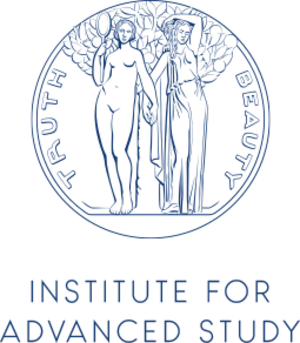 |
|
| Motto | Truth and Beauty |
|---|---|
| Type | Private |
| Established | 1930 |
| Founder | Abraham Flexner |
| Endowment | $784.7 million (2020) |
| Director | David Nirenberg |
|
Academic staff
|
25 (current faculty only) |
|
Administrative staff
|
26 |
| Students | None |
| Location |
,
,
US
|
| Campus | Suburban |
 |
|
The Institute for Advanced Study (IAS) is a special place in Princeton, New Jersey. It's a research center where brilliant thinkers come to explore big ideas. It's not a regular university. There are no classes, no students earning degrees, and no grades!
Many famous scholars have worked here. These include Albert Einstein, J. Robert Oppenheimer, and Emmy Noether. Many of them came to the United States from Europe.
The IAS was started in 1930 by Abraham Flexner. He worked with two generous people, Louis Bamberger and Caroline Bamberger Fuld. Even though it's near Princeton University, the IAS is completely separate. It also doesn't charge any money for people to study there.
Flexner believed in seeking knowledge just for the sake of learning. Researchers at the IAS are free to follow their own curiosity. They don't have to teach or work on specific projects. This freedom helps them make amazing discoveries. The IAS became a very important place for smart people leaving Europe during a difficult time. It quickly became known as a top place for academic and scientific work.
The institute has four main areas of study, called "schools." These are Historical Studies, Mathematics, Natural Sciences, and Social Sciences. There's also a program for Systems Biology. The IAS gets its money from donations and grants. It's a model for other similar research centers around the world.
Contents
History of the IAS
How the Institute Started
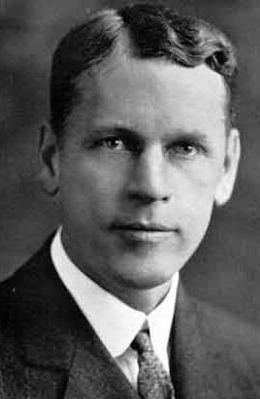
The Institute for Advanced Study began in 1930. It was founded by Abraham Flexner and the generous siblings Louis Bamberger and Caroline Bamberger Fuld. Flexner had always been interested in education. He even started an experimental school in 1890. This school had no set lessons, no tests, and no grades. Yet, its students did very well in college. This idea of learning freely later guided him at the IAS.
Flexner had also studied top schools in Europe. He wanted to create a similar advanced research center in the United States. He believed in a place where scholars could focus only on new ideas.
In 1929, Flexner got a call from the Bamberger family. They had sold their department store and wanted to use the money for a good cause. They first thought about funding a dental school. But Flexner convinced them to support more abstract research. Luckily, the Bambergers moved their money just before the stock market crash of 1929.
Oswald Veblen, a brilliant mathematician from Princeton University, suggested a location. He thought the new institute should be near Princeton. This way, it would be close to a great university and a large library. In 1932, Veblen joined the IAS as its first professor. He helped choose the first group of scholars. He also helped the institute buy land in Princeton.
Flexner and Veblen worked hard to find the best mathematicians and physicists. Many top scholars were leaving Europe because of rising political problems. Some, like Albert Einstein and Hermann Weyl, found a safe home at the new institute. Weyl even insisted that John von Neumann, a brilliant young scholar, also be invited. The IAS became a vital place for scholars escaping Europe. Einstein was a huge success for Flexner. Soon after, other great minds like James Alexander and Kurt Gödel joined. By 1934, the new institute had six of the world's leading mathematicians. In 1935, Wolfgang Pauli, a pioneer in quantum physics, also joined. With the IAS opening, Princeton became a leading center for mathematics.
The Early Years
For its first six years, the institute was located inside Princeton University. It was in Fine Hall, where Princeton's math department was. The two institutions were close and often worked together. This led many people to mistakenly think the IAS was part of the university. This idea has been hard to change.
In 1930, the Bamberger family wrote an important statement. They said that when choosing staff, faculty, or visitors, no one should be judged by their race, religion, or gender. They strongly believed that higher learning should be open to everyone.
However, Princeton University did not always follow this policy. In 1937, when an African-American mathematician named William S. Claytor applied, Princeton University said they would not allow him to come. It wasn't until 1939, when the IAS moved into its own building, that Veblen could offer Claytor a position. But by then, Claytor turned it down.
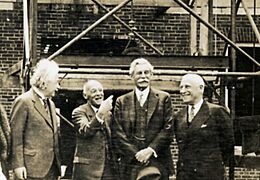
Flexner successfully gathered an amazing group of scholars for the School of Mathematics, which opened in 1933. He also wanted to create schools for economics and humanities. The School of Humanistic Studies and the School of Economics and Politics were started in 1935. All three schools moved into the new Fuld Hall in 1939. Later, the humanities and economics schools combined to form the School of Historical Studies in 1949. At first, the School of Mathematics included physicists. A separate School of Natural Sciences was created in 1966. The School of Social Science was founded in 1973.
The Institute's Purpose
In 1939, Abraham Flexner wrote about the importance of curiosity. He explained how James Clerk Maxwell, driven only by a desire to understand, did complex calculations about magnetism and electricity. These studies directly led to all the electrical technology we have today. Flexner said that many great discoveries, which have helped humanity, were made by people who simply wanted to satisfy their curiosity. They weren't trying to be "useful" at first.
The IAS believes that seeking knowledge for its own sake is its main goal. They say that new ideas, which are key to understanding nature and humanity, cannot be forced. Instead, like art, they need a special environment to grow. This belief was very important to Flexner and still guides the institute today.
Amazing Discoveries and People
Since it opened, the IAS has had a huge impact on mathematics, physics, and other fields. Many top award winners have been connected to the institute. For example, 42 out of 61 Fields Medalists (a top math award) have been linked to the IAS. Also, 34 Nobel Laureates have worked there. Many winners of the Abel Prize and Cole Prize in mathematics have also been part of the IAS. Its more than 6,000 former members now hold important positions in universities and research centers worldwide.
Important work on the idea of the stored-program computer was done at the IAS by John von Neumann. The IAS machine, built in Fuld Hall from 1942 to 1951, created the basic design for most modern digital computers. The IAS is also a leading center for research in string theory, a complex idea in physics. The Langlands program, a big idea that connects different parts of mathematics, was developed by Robert Langlands at the IAS. He now works in Albert Einstein's old office.
The institute has been home to many of the smartest people of their time. These include James Waddell Alexander II, Michael Atiyah, Albert Einstein, Kurt Gödel, J. Robert Oppenheimer, John von Neumann, and Edward Witten.
Special Year Programs
Flexner's idea of how great discoveries happen is shown by the "Special Year" programs at the IAS School of Mathematics. For example, in 2012–13, researchers held a "Special Year on Univalent Foundations of Mathematics." This program brought together experts from different areas of math and computer science. Their goal was to develop a new way of thinking about the basic rules of mathematics.
More than 30 researchers worked together on this project. They published a book that became very important in this new field. One of the researchers, Andrej Bauer, said it was amazing how a group of two dozen mathematicians wrote a 600-page book in less than half a year. He noted the incredible spirit of teamwork at the IAS. They talked, shared ideas, and helped each other, forgetting who did what. This book is available for free online.
School of Social Science
The School of Social Science started in 1973. It focuses on new ways to study society. Researchers here look at social issues from many different angles. They use various methods and include international perspectives. Some current professors include Wendy Brown, Didier Fassin, and Alondra Nelson. Past professors include Clifford Geertz and Michael Walzer.
Other Institutes for Advanced Study
The IAS in Princeton is known as the world's first Institute for Advanced Study. It took many years for other similar places to be created. The Center for Advanced Study in the Behavioral Sciences in Stanford was the first in 1954. Then came the National Humanities Center in North Carolina in 1978. These two became part of a group called "Some Institutes for Advanced Study (SIAS)."
The SIAS group includes the original IAS in Princeton and nine other institutes. These other institutes were specifically created to be like the IAS model. Here are some of them:
- Center for Advanced Study in the Behavioral Sciences in Stanford, California
- National Humanities Center in North Carolina
- Radcliffe Institute for Advanced Study in Cambridge, Massachusetts
- The Institute for Advanced Study in the Humanities (KWI) in Essen, Germany
- Netherlands Institute for Advanced Study in Amsterdam, the Netherlands
- Swedish Collegium for Advanced Study in Uppsala, Sweden
- Berlin Institute for Advanced Study in Berlin, Germany
- Israel Institute for Advanced Studies in Jerusalem
- Nantes Institute for Advanced Study Foundation in Nantes, France
- Stellenbosch Institute for Advanced Study in Stellenbosch, South Africa
- Institute for Advanced Study in Princeton, New Jersey
In recent years, other institutes have been started that are loosely based on the Princeton model. Some IAS professors have even helped set them up. For example, in 1997, IAS professor Chen-Ning Yang helped China create an Institute for Advanced Study at Tsinghua University in Beijing. The Freiburg Institute for Advanced Studies in Germany was founded in 2007.
The Institut des Hautes Études Scientifiques (IHÉS) in France, founded in 1958, was inspired by the Princeton IAS. Robert Oppenheimer, a director at the Princeton Institute, helped get it started. The Dublin Institute for Advanced Studies, founded in 1940, was also based on the IAS.
It's important not to confuse the Princeton IAS or the SIAS group with other organizations. Many places around the world use the name "Institute for Advanced Study" or the acronym "IAS." But they might not follow the same model as the original Princeton institute.
Leaders, Scholars, and Visitors
The IAS has about 28 very important scholars who work there for life. These scholars don't teach classes, but they often give talks. They also guide a larger group of younger scholars who visit the institute. Each year, about 190 visiting scholars from over 100 universities come to the IAS. They stay for a few months or even a few years. People who want to visit must apply, and each school has its own application process.
| Directors of the IAS | |
|---|---|
| Name | Term |
| Abraham Flexner | 1930–1939 |
| Frank Aydelotte | 1939–1947 |
| J. Robert Oppenheimer | 1947–1966 |
| Carl Kaysen | 1966–1976 |
| Harry Woolf | 1976–1987 |
| Marvin Leonard Goldberger | 1987–1991 |
| Phillip Griffiths | 1991–2003 |
| Peter Goddard | 2004–2012 |
| Robbert Dijkgraaf | 2012–2022 |
| David Nirenberg | 2022–present |
Campus and Historic Buildings
The IAS owns over 600 acres of land. Most of this land was bought between 1936 and 1945. Since 1997, the institute has protected 589 acres of woods, wetlands, and farmland. By 1936, the founders had bought 256 acres for $290,000. This included the 200-acre Olden Farm and Olden Manor. Olden Manor was once the home of William Olden. Since 1940, Olden Manor, with its large gardens, has been the home of the institute's director.
Olden Manor is a large house on the main campus. It is where the Director and their family live. The Director also uses it for official events and meetings for the faculty and trustees.
Images for kids
See also
 In Spanish: Instituto de Estudios Avanzados (Princeton) para niños
In Spanish: Instituto de Estudios Avanzados (Princeton) para niños
- List of Nobel laureates affiliated with the Institute for Advanced Study
- List of Fields medalists affiliated with the Institute for Advanced Study
- Some Institutes for Advanced Study


